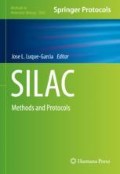Abstract
The protein cargo of extracellular vesicles (EVs) determines their impact on recipient cell types and the downstream effects on biological function. Environmental cues can modify EV loading with proteins derived from the plasma membrane via endocytosis, obtained from the preexisting cytosolic pool via active sorting, or packaging with newly synthesized proteins drawn from trans-golgi networks. Given the major impact these pathways exert on EV content and functional potential, it is important to study how defined stimuli influence protein sorting into these vesicles for dispersal. To this end, pSILAC-based approaches can be used to pulse/trace the origins of EV protein content and thereby provide valuable insight into vesicle biology and likely effects on intercellular communication in diverse settings.
Access this chapter
Tax calculation will be finalised at checkout
Purchases are for personal use only
References
Théry C, Witwer KW, Aikawa E, Alcaraz MJ, Anderson JD, Andriantsitohaina R et al (2018) Minimal information for studies of extracellular vesicles 2018 (MISEV2018): a position statement of the International Society for Extracellular Vesicles and update of the MISEV2014 guidelines. J Extracell Vesicles 7:1535750. https://doi.org/10.1080/20013078.2018.1535750
Kalluri R, LeBleu VS (2020) The biology, function, and biomedical applications of exosomes. Science 367:eaau6977. https://doi.org/10.1126/science.aau6977
Lai RC, Arslan F, Lee MM, Sze NS, Choo A, Chen TS et al (2010) Exosome secreted by MSC reduces myocardial ischemia/reperfusion injury. Stem Cell Res 4:214–222. https://doi.org/10.1016/j.scr.2009.12.003
Park JE, Dutta B, Tse SW, Gupta N, Tan CF, Low JK et al (2019) Hypoxia-induced tumor exosomes promote M2-like macrophage polarization of infiltrating myeloid cells and microRNA-mediated metabolic shift. Oncogene 38:5158–5173. https://doi.org/10.1038/s41388-019-0782-x
Gallart-Palau X, Guo X, Serra A, Sze SK (2020) Alzheimer’s disease progression characterized by alterations in the molecular profiles and biogenesis of brain extracellular vesicles. Alzheimers Res Ther 12:54. https://doi.org/10.1186/s13195-020-00623-4
Tse SW, Tan CF, Park JE, Gnanasekaran J, Gupta N, Low JK et al (2020) Microenvironmental hypoxia induces dynamic changes in lung cancer synthesis and secretion of extracellular vesicles. Cancer 12:2917. https://doi.org/10.3390/cancers12102917
Tan CF, Teo HS, Park JE, Dutta B, Tse SW, Leow MK et al (2020) Exploring extracellular vesicles biogenesis in hypothalamic cells through a heavy isotope pulse/trace proteomic approach. Cell 9:1320. https://doi.org/10.3390/cells9051320
Gupta N, Park JE, Tse W, Low JK, Kon OL, McCarthy N, Sze SK (2019) ERO1α promotes hypoxic tumor progression and is associated with poor prognosis in pancreatic cancer. Oncotarget 10:5970–5982. https://doi.org/10.18632/oncotarget.27235
Park JE, Tse SW, Xue G, Assisi C, Maqueda AS, Ramon GPX et al (2019) Pulsed SILAC-based proteomic analysis unveils hypoxia- and serum starvation-induced de novo protein synthesis with PHD finger protein 14 (PHF14) as a hypoxia sensitive epigenetic regulator in cell cycle progression. Oncotarget 10:2136–2150. https://doi.org/10.18632/oncotarget.26669
Chua SL, Yam JK, Hao P, Adav SS, Salido MM, Liu Y et al (2016) Selective labelling and eradication of antibiotic-tolerant bacterial populations in Pseudomonas aeruginosa biofilms. Nat Commun 7:10750. https://doi.org/10.1038/ncomms10750
Acknowledgments
This work is in part supported by the Singapore National Medical Research Council (NMRC/OFIRG/0003/2016) and Singapore Ministry of Education (MOE2018-T1-001-078).
Author information
Authors and Affiliations
Corresponding author
Editor information
Editors and Affiliations
Rights and permissions
Copyright information
© 2023 The Author(s), under exclusive license to Springer Science+Business Media, LLC, part of Springer Nature
About this protocol
Cite this protocol
Ngan, SF.C., McCarthy, N.E., Sze, S.K. (2023). pSILAC-Based Determination of Cellular Protein Sorting into Extracellular Vesicles. In: Luque-Garcia, J.L. (eds) SILAC. Methods in Molecular Biology, vol 2603. Humana, New York, NY. https://doi.org/10.1007/978-1-0716-2863-8_4
Download citation
DOI: https://doi.org/10.1007/978-1-0716-2863-8_4
Published:
Publisher Name: Humana, New York, NY
Print ISBN: 978-1-0716-2862-1
Online ISBN: 978-1-0716-2863-8
eBook Packages: Springer Protocols

